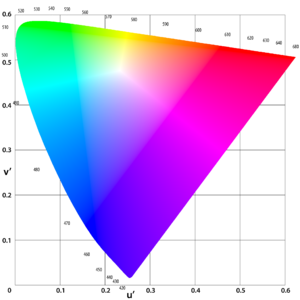
A | B | C | D | E | F | G | H | CH | I | J | K | L | M | N | O | P | Q | R | S | T | U | V | W | X | Y | Z | 0 | 1 | 2 | 3 | 4 | 5 | 6 | 7 | 8 | 9
In colorimetry, the CIE 1976 L*, u*, v* color space, commonly known by its abbreviation CIELUV, is a color space adopted by the International Commission on Illumination (CIE) in 1976, as a simple-to-compute transformation of the 1931 CIE XYZ color space, but which attempted perceptual uniformity. It is extensively used for applications such as computer graphics which deal with colored lights. Although additive mixtures of different colored lights will fall on a line in CIELUV's uniform chromaticity diagram (called the CIE 1976 UCS), such additive mixtures will not, contrary to popular belief, fall along a line in the CIELUV color space unless the mixtures are constant in lightness.
Historical background
CIELUV is an Adams chromatic valence color space and is an update of the CIE 1964 (U*, V*, W*) color space (CIEUVW). The differences include a slightly modified lightness scale and a modified uniform chromaticity scale, in which one of the coordinates, v′, is 1.5 times as large as v in its 1960 predecessor. CIELUV and CIELAB were adopted simultaneously by the CIE when no clear consensus could be formed behind only one or the other of these two color spaces.
CIELUV uses Judd-type (translational) white point adaptation (in contrast with CIELAB, which uses a von Kries transform).[1] This can produce useful results when working with a single illuminant, but can predict imaginary colors (i.e., outside the spectral locus) when attempting to use it as a chromatic adaptation transform.[2] The translational adaptation transform used in CIELUV has also been shown to perform poorly in predicting corresponding colors.[3]
XYZ → CIELUV and CIELUV → XYZ conversions
By definition, 0 ≤ L* ≤ 100 .
The forward transformation
CIELUV is based on CIEUVW and is another attempt to define an encoding with uniformity in the perceptibility of color differences.[4] The non-linear relations for L*, u*, and v* are given below:[4]
The quantities u′n and v′n are the (u′, v′) chromaticity coordinates of a "specified white object" – which may be termed the white point – and Yn is its luminance. In reflection mode, this is often (but not always) taken as the (u′, v′) of the perfect reflecting diffuser under that illuminant. (For example, for the 2° observer and standard illuminant C, u′n = 0.2009, v′n = 0.4610.) Equations for u′ and v′ are given below:[5][6]
The reverse transformation

The transformation from (u′, v′) to (x, y) is:[6]
The transformation from CIELUV to XYZ is performed as follows:[6]
Cylindrical representation (CIELCh)
CIELChuv, or HCL color space (hue–chroma–luminance) is increasingly seen in the information visualization community as a way to help with presenting data without the bias implicit in using varying saturation.[7][8][9]
The cylindrical version of CIELUV is known as CIELChuv, or CIELChuv, CIELCh(uv) or CIEHLCuv, where C*uv is the chroma and huv is the hue:[6]
Antropológia
Aplikované vedy
Bibliometria
Dejiny vedy
Encyklopédie
Filozofia vedy
Forenzné vedy
Humanitné vedy
Knižničná veda
Kryogenika
Kryptológia
Kulturológia
Literárna veda
Medzidisciplinárne oblasti
Metódy kvantitatívnej analýzy
Metavedy
Metodika
Text je dostupný za podmienok Creative
Commons Attribution/Share-Alike License 3.0 Unported; prípadne za ďalších
podmienok.
Podrobnejšie informácie nájdete na stránke Podmienky
použitia.
www.astronomia.sk | www.biologia.sk | www.botanika.sk | www.dejiny.sk | www.economy.sk | www.elektrotechnika.sk | www.estetika.sk | www.farmakologia.sk | www.filozofia.sk | Fyzika | www.futurologia.sk | www.genetika.sk | www.chemia.sk | www.lingvistika.sk | www.politologia.sk | www.psychologia.sk | www.sexuologia.sk | www.sociologia.sk | www.veda.sk I www.zoologia.sk




